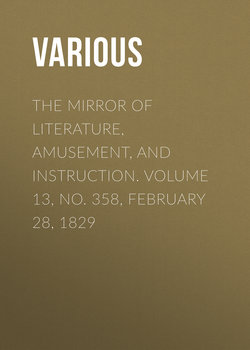The Mirror of Literature, Amusement, and Instruction. Volume 13, No. 358, February 28, 1829

Реклама. ООО «ЛитРес», ИНН: 7719571260.
Оглавление
Various. The Mirror of Literature, Amusement, and Instruction. Volume 13, No. 358, February 28, 1829
YORK TERRACE,
REGENT'S PARK
VALENTINE CUSTOMS
LINES
COINAGE OF THE ANCIENT BRITONS
ANIMAL FOOD
WHITEHALL. MARRIAGE OF ANNE BOLEYN
Memorable Days
COLLOP MONDAY
The Contemporary Traveller
DESCRIPTION OF MEKKA
The Naturalist
FLAKES OF SNOW MAGNIFIED
MONKEYS AT GIBRALTAR
The Selector, AND LITERARY NOTICES OF NEW WORKS
THE GREAT WORLD OF FASHION
OLD POETS
A KISS
SIGHT
MERCY AND JUSTICE
INGRATITUDE
HEAVEN
MARRIAGE
PRIDE
SPIRIT OF THE Public Journals
NOTES FROM THE LONDON REVIEW, NO. 1. ANCIENT AND MODERN LUXURIES
THE STAGE
ENGLISH WOMEN
CRIME IN PARIS
WITNESSES
YOU'LL COME TO OUR BALL
PARTY
The Anecdote Gallery
MOLIERE
DOMESTIC HABITS OF NAPOLEON
The Gatherer
RETENTIVE MEMORY
EVE'S TOMB
ACROSTIC ON THE EYES
VOLTAIRE
VENTILATION
ACROSTIC TO BRAHAM
Отрывок из книги
If the reader is anxious to illustrate any political position with the "signs of the times," he has only to start from Waterloo-place, (thus commencing with a glorious reminiscence,) through Regent-street and Portland-place, and make the architectural tour of the Regent's Park. Entering the park from the New Road by York Gate, one of the first objects for his admiration will be York Terrace, a splendid range of private residences, which has the appearance of an unique palace. This striking effect is produced by all the entrances being in the rear, where the vestibules are protected by large porches. All the doors and windows in the principal front represented in the engraving are uniform, and appear like a suite of princely apartments, somewhat in the style of a little Versailles. This idea is assisted by the gardens having no divisions.
The architecture of the building is Græco-Italian. It consists of an entrance or ground story, with semicircular headed windows and rusticated piers. A continued pedestal above the arches of these windows runs through the composition, divided between the columns into balustrades, in front of the windows of the principal story, to which they form handsome balconies. The elegant windows of this and the principal chamber story are of the Ilissus Ionic, and are decorated with a colonnade, completed with a well-proportioned entablature from the same beautiful order. Mr. Elmes, in his critical observations on this terrace, thinks the attic story "too irregular to accompany so chaste a composition as the Ionic, to which it forms a crown;" he likewise objects to the cornice and blocking-course, as being "also too small in proportion for the majesty of the lower order."
.....
In 1749, a considerable number of gold coins were discovered on the top of Karnbre, in Cornwall, which are clearly proved to have belonged to the ancient Britons. The figures that were first stamped on the coins of all nations were those of oxen, horses, sheep, &c. It may, therefore, be concluded, that the coins of any country which have only the figures of cattle stamped on them, and perhaps of trees, representing the woods in which their cattle pastured,—were the most ancient coins of the country. Some of the gold coins found at Karnbre, and described by Dr. Borlase, are of this kind, and may be justly esteemed the most ancient of our British coins. Sovereigns soon became aware of the importance of money, and took the fabrication of it under their own direction, ordering their own heads to be impressed on one side of the coins, while the figure of some animal still continued to be stamped on the other. Of this kind are some of the Karnbre coins, with a royal head on one side, and a horse on the other. When the knowledge and use of letters were once introduced into any country, it would not be long before they appeared on its coins, expressing the names of the princes whose heads were stamped on them. This was a very great improvement in the art of coining, and gave an additional value to the money, by preserving the memories of princes, and giving light to history. Our British ancestors were acquainted with this improvement before they were subdued by the Romans, as several coins of ancient Britain have very plain and perfect inscriptions, and on that account merit particular attention.
It is generally allowed, that a profusion of animal food has a tendency to vitiate and debase the nature and dispositions of men; notwithstanding, the lovers of flesh urge the names of many of the most eminent in literature and science, in opposition to this assertion.
.....